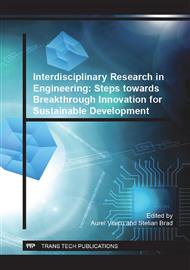[1]
S. Thamarai Selvi, P. Perumal, Blended learning for programming in cloud based e-Learning system, Proceedings of the ICRTIT Conference – Recent Trends In Information Technology, (2012) 197-201.
DOI: 10.1109/icrtit.2012.6206811
Google Scholar
[2]
R. Manseur and Z. Manseur, A Synchronous Distance Learning Program Implementation in Engineering and Mathematics, Proceedings of the 39th ASEE/IEEE Frontiers in Education Conference, San Antonio, Texas, (2009) 1-6.
DOI: 10.1109/fie.2009.5350867
Google Scholar
[3]
M. Qiu, and L. Chen, A Problem-based Learning Approach to Teaching an Advanced Software Engineering Course, Proceedings of the 2nd International Workshop on Education Technology and Computer Science, (2011) 252-255.
DOI: 10.1109/etcs.2010.339
Google Scholar
[4]
K. Sugawara, S. Fujita, and H. Hara, A Concept of Symbiotic Computing and its Application to Telework, Proceedings of the 6th IEEE Int. Conf. on Cognitive Informatics (2007) 302-311.
DOI: 10.1109/coginf.2007.4341903
Google Scholar
[5]
T. Kuroda, A. Sakatoku, G Kitagata, D. Chakraborty, and Norio Shiratori, Open 3D Shared Space Construction Scheme for Symbiotic CollaborativeWorks, Proceedings of the 28th International Conference on Distributed Computing Systems Workshops, (2008).
DOI: 10.1109/icdcs.workshops.2008.89
Google Scholar
[6]
S. Leone, T. Leo, and N. Chen, An integrated model of synchronous cyber assessment and blended learning environment for foreign language learners, Proceedings of the 10th IEEE International Conference on Advanced Learning Technologies, (2010).
DOI: 10.1109/icalt.2010.38
Google Scholar
[7]
J.E. Mitchell, B. Canavan, and J. Smith. Problem-based learning in communication systems: student perceptions and achievement, IEEE Transactions on education, (2010), Volume: 53, Issue: 4 , 587-594.
DOI: 10.1109/te.2009.2036158
Google Scholar
[8]
M. Llamas-Nistal, M. Caeiro-Rodriguez, and M. Castro. Use of e-learning functionalities and standards: the Spanish case, IEEE Transactions on education, (2011), Volume: 54, Issue: 4, 540–549.
DOI: 10.1109/te.2010.2090154
Google Scholar
[9]
L. Shaozi, Q. Zhongpan, L. Tangqui, C. Huowang, Architecture of computer supported collaborative learning based on EJB middleware and it's implementation, Proceedings of the 8th International Conference on Computer Supported Cooperative Work in Design. Vol. 1 (2003).
DOI: 10.1109/cacwd.2004.1349003
Google Scholar
[10]
A. Aguilar, A. de Antonio, and R. Imbert, An intelligent collaborative environment for team training – A preliminary report", Proceedings of the 15th International Conference on Computing (2006) 236-239. Reference to a chapter in an edited book.
DOI: 10.1109/cic.2006.23
Google Scholar
[11]
C. Porumb, S. Porumb, B. Orza, A. Vlaicu, Collaborative learning tools in higher education and lifelong learning, in: P. Isaias, D. Ifenthaler, K. Sampson, and J.M.G. Spector. Towards learning and instruction in Web 3. 0, Springer Publishing House, 2011, pp.89-105.
DOI: 10.1007/978-1-4614-1539-8_6
Google Scholar


